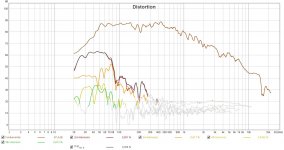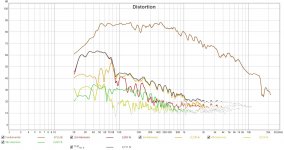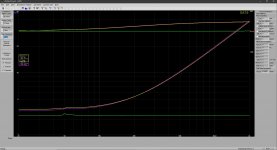WEll i posted a measurement Air coil vs Iron core on a facebook group. i measured the actually output from my speaker to see what would happen (dont mention overal distortion its about the difference.)
And i get allot of comments about what i try to do cant be done, you mic is not accurate enough to measure this kind of distortion and i measure wrong, i have to realign the filter etc etc..
in my honest opinion the way i measured it might not give the greatest detail but will show witch coil i would use and witch i wont in a planar magnetic...
Speaker used Planar magnetic bass, amplifier hypex NC400 class D , mic isemcon emx-7150 perfectly capable of measuring what i can even hear.
FR of the 3mH Iron Core and the 3mH air coil.

Distortion of the AIR coil

Distortion of the IRON core

Impedance measurement of both coils since i was told the filter needed to be realigned and the Q changes because of the significant difference in resistance 🙂 0.14ohm..
Green no coil
Yellow Air coil
Purple Iron Core

No what baffles me is the enormous added distortion with the iron core, you can even hear distortion riding on the fundamental. not pleasant.
any idea why this is so dramatic >?can it be something with combining it with a resistive load like a planar ? or is the class D amp going mad ? (would be shamefull)
or is it just Hysteresis Distortion, and these coils would suck in any case.
And i get allot of comments about what i try to do cant be done, you mic is not accurate enough to measure this kind of distortion and i measure wrong, i have to realign the filter etc etc..
in my honest opinion the way i measured it might not give the greatest detail but will show witch coil i would use and witch i wont in a planar magnetic...
Speaker used Planar magnetic bass, amplifier hypex NC400 class D , mic isemcon emx-7150 perfectly capable of measuring what i can even hear.
FR of the 3mH Iron Core and the 3mH air coil.

Distortion of the AIR coil

Distortion of the IRON core

Impedance measurement of both coils since i was told the filter needed to be realigned and the Q changes because of the significant difference in resistance 🙂 0.14ohm..
Green no coil
Yellow Air coil
Purple Iron Core

No what baffles me is the enormous added distortion with the iron core, you can even hear distortion riding on the fundamental. not pleasant.
any idea why this is so dramatic >?can it be something with combining it with a resistive load like a planar ? or is the class D amp going mad ? (would be shamefull)
or is it just Hysteresis Distortion, and these coils would suck in any case.
at higher volumes the distortion would come a bit closer together air vs iron. but Iron would still be in the lead with 1.7 times the distortion of the air coil
0.128 vs 2.16 might be just because the overall distortion goes up the percentage the iron core added becomes less and less.
0.128 vs 2.16 might be just because the overall distortion goes up the percentage the iron core added becomes less and less.
Looks like you are getting much more H3 in the low end with the iron core?
You could always measure at the speaker terminals to determine what that looks like compared to your mic.
You could always measure at the speaker terminals to determine what that looks like compared to your mic.
With the frequency range you are showing the increase in distortion sure looks hysteresis related.
Roughly what voltage level were those measurements taken at?
Can you share what brand of iron core you are using?
The Erse IXQ core coils I measured produced much less distortion than the no-name coils I was replacing in a recent loudspeaker crossover upgrade project.
Roughly what voltage level were those measurements taken at?
Can you share what brand of iron core you are using?
The Erse IXQ core coils I measured produced much less distortion than the no-name coils I was replacing in a recent loudspeaker crossover upgrade project.
Steel laminate types are the best cored coils per cost.
Steel rod cores are horrible in sound and swturate too easily.
Pcores/ferrite are prone to saturate easily.
Ccoils from Jantzen are really good too, but only to lower frequencies.
Steel rod cores are horrible in sound and swturate too easily.
Pcores/ferrite are prone to saturate easily.
Ccoils from Jantzen are really good too, but only to lower frequencies.
Probably the hysteresis. This is not linear and will produced distortion. it can be minimised by ensuring that the iron core does not get anywhere near saturation. If your cores are complete magnetic circuits, they will enable the core to saturate at low current. Use an open core (linear) or a core with an air gap. For audio output stages most people use air cored coils for the very reason that they have no saturation nor hysteresis to be conncered with.
- Home
- Loudspeakers
- Planars & Exotics
- Iron Core coils on a planar magnetic